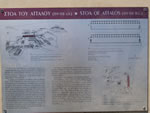 The long corridor style museum lies within the reconstructed Stoa of Attalos II, King of Pergamum which itself resides in the precinct of the ancient Athenian agora. Click the image right to see the in-situ explanatory sign provided by the Greek Authorities. This page concerns the Agora Museum and justs skims the surface of the Athenian Agora and the Hephaistion also contained within it.
The long corridor style museum lies within the reconstructed Stoa of Attalos II, King of Pergamum which itself resides in the precinct of the ancient Athenian agora. Click the image right to see the in-situ explanatory sign provided by the Greek Authorities. This page concerns the Agora Museum and justs skims the surface of the Athenian Agora and the Hephaistion also contained within it.
Attalos complete history is shrouded in the mists of antiquity but its safe to say he was a Phihellene (a friend of Greece) since was a Roman administrator at the time and benefactor to the city of Athens this is safe to assume.
His father had discovered a vast amid mysterious treasure buried on his Attik property. Son Attalos inherited and spread the wealth around. Like Hadrian we'll run into Attalos again and again in ancient Athens.
Attalos' original stoa was constructed in the 2nd century BC and reconstructed by the American School of Classical Studies primarily funded by the Rockefeller Foundation. Toilet facilities are to be found within the museum as well as a free drinking fountain which is a nice thoughtful touch for a Greek Archeological site.
The museums finds primarily have to do with the social and political life of the city of ancient Athens. The ancient agora was the center point of daily life for male citizens. The stoa is where the philosophic term "Stoic" comes from as the Stoics lectured here.
The museum also contains finds from the (c 3,000 BC) Neolithic era wells found near-by and up until the 6th century AD when the Byzantine Emperor Justinian closed the philosophic Schools and the agora became deserted.
The stoa's initial primary function was as a place to buy food stuffs and products. It evolved to become the center of ancient Athenian political life and intellectual discourse. A bewildering number of temples and official buildings were erected on its grounds thru various epochs. Many were built on the foundations of previous structures and some even used the earlier marble blocks and quarried stone.
90% of these structures are long gone, as are gone medieval and latter structures which archeologists tore down to reach these classical period ruins. Urban renewal and tourist dollars. The Stoa itself is 120 meters long and 20 meters deep and had two floors with a second series of columns in the interior and 21 stores on both floors. On the upper floor the exterior collonade was Ionic while on the lower floor the exterior were Doric without fluting and the interior Ionic with capitols of a Peragamene style.